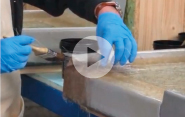Fibreglass Pond Building FAQ'S
Click a question to reveal the answer!
A: Do NOT use resin with cement it doesn't work. The following powders are ideal: Fillite (fly ash) Talc Marble Flour DRY bath sand Most powders are available from us, the most popular being Fillite which is approx. £17.50 inc. VAT for a 20kg bag. Process for mixing filler to resin: 1. Mix the resin and hardener in the normal way 2. Mix in the filler ready to use.
A: A concrete base is not necessarily needed for building a glass fibre pond. We recommend that you build your pond in 4 stages:
- 1. Dig your hole to the required shape and size
- 2. Flatten the mud to give an even surface to work on
- 3. Lightly render with sand and cement then lightly sand the surface leaving a smooth base.
- 4. You are now ready to laminate your pond with resin and mat.
A: A glass fibre laminate can be used to coat a concrete pond but you are, in effect forming another pond inside your original one. We recommend using 2 layers of matting with the appropriate resin and gel coat to form a pond that will last many years within a concrete base. Once the glass fibre laminate goes hard the cracking and ground movement will not effect the laminate at all (it has a certain amount of give).
A: Am I right in presuming that the pond liner that you are talking about is a rubber type one? If so, then I am afraid that we do not have any details of adhesives for this type of product, we only deal with GRP ponds (glass reinforced plastic). I suggest that you try the lining manufacturer. Sorry we couldn't be of any help.
A: Surface tissue has got a very high resin pick up so is normally used against gel coat when working on a "mould". We do not see any advantage in the use of surface tissue when sheathing a pond. Providing the chopped strand laminate is properly rolled and consolidated, the flow coat will be sufficient in achieving a smooth surface and prevent wicking.
A: Yes it is possible, you need to clean the area thoroughly (preferably using Acetone) then sand back the surface before carrying out your repair.
A: The usual problem is that the matting has not been rolled out/wetted out correctly with the metal roller which results in dry areas of matting that penetrate through the flowcoat. This enables the water to come through the laminate. If this is the case you will see very small pinholes in the flow coat that need filling - the easiest way is to plug the hole with plasticine then overcoat with another layer of matting and gel coat (please contact us for further advice if you are going to take this route).


fibreglass supplies for flat roofing and all types of fibreglass projects
connect with us >